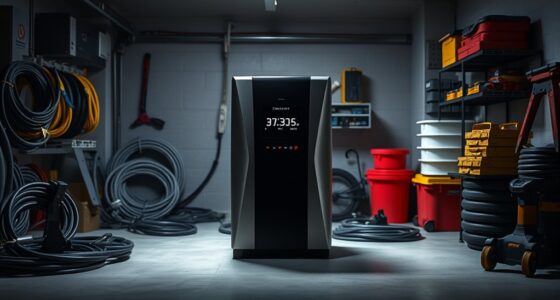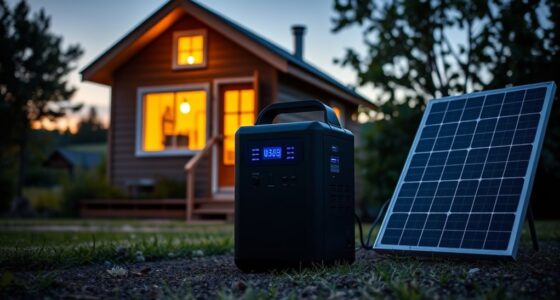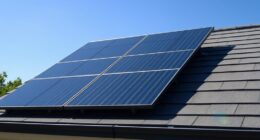When you buy a portable power station, watch out for hidden costs like ongoing maintenance, unexpected repair bills, and future upgrades. You might also need to replace accessories or batteries sooner than expected, which can add up quickly. Plus, cheaper materials can lead to early failures, increasing your expenses over time. To keep surprises at bay, it’s crucial to think about these factors now—and there’s more to uncover if you explore further.
Key Takeaways
- Ongoing maintenance like cleaning and component replacements can significantly increase total ownership costs.
- Warranties often cover limited parts, leading to unexpected expenses for repairs or damages.
- Battery replacements and accessory upgrades are costly and may be needed sooner than expected.
- Low-quality materials can cause premature failures, increasing long-term repair and replacement expenses.
- Hidden costs such as extended warranties, future upgrades, and unforeseen repairs can strain your budget.

Portable power stations are often marketed as convenient, hassle-free solutions for backup power or outdoor adventures, but their true costs go beyond the initial price tag. While the upfront expense might seem manageable, you’ll need to contemplate ongoing expenses that can add up quickly. One of these hidden costs involves solar maintenance. If you plan to rely on solar panels to recharge your station, regular upkeep is essential to keep everything functioning efficiently. Dust, debris, and weather conditions can diminish solar panel performance over time, meaning you’ll need to clean or replace components to maintain ideal charging capabilities. These maintenance tasks aren’t always apparent at purchase and can catch you off guard when your station’s solar input drops unexpectedly.
Another often overlooked expense relates to warranty coverage. While many portable power stations come with a manufacturer’s warranty, it rarely covers everything. You might think that a warranty will protect you from costly repairs, but it’s usually limited to specific components or defect-related issues. If your device breaks down due to accidental damage, misuse, or normal wear and tear, you could find yourself footing the bill for repairs or replacements. Extended warranties or service plans can help, but they come at additional costs that many owners forget to budget for. Without proper warranty coverage, even a minor malfunction could turn into a significant expense, especially if parts need replacing or if you require professional repairs.
Warranty coverage often excludes accidental damage and wear, leading to unexpected repair costs.
Beyond these, you should also be aware of the potential costs for accessories or upgrades. For example, if your portable power station isn’t compatible with current or future solar panels, you might need to buy adapters or entirely new equipment. Similarly, batteries have limited lifespans, and replacing them can be expensive, especially if your station doesn’t include a thorough warranty. These expenses aren’t always transparent at purchase time, and they can stretch your budget well beyond the initial investment.
Another important consideration is the Materials used in the construction of your portable power station, as cheaper materials may lead to higher long-term repair or replacement costs. In essence, owning a portable power station isn’t just about paying the sticker price. You need to account for ongoing solar maintenance, which guarantees your system remains efficient, and carefully review warranty coverage to avoid unforeseen repair costs. Planning for these hidden expenses helps you avoid surprises and ensures your portable power station remains a reliable resource when you need it most. By understanding these potential costs upfront, you can better manage your budget and enjoy the convenience of portable power without financial stress.
Frequently Asked Questions
Are Portable Power Stations Covered by Insurance?
You might wonder if portable power stations are covered by insurance. Generally, insurance coverage for these devices depends on your policy and the circumstances of damage or theft. Most warranty policies cover manufacturing defects but don’t extend to accidental damage or loss. It’s wise to check your warranty policies and contact your insurer to understand what’s included, ensuring you’re protected from unexpected costs.
Do Portable Power Stations Require Professional Installation?
Think of installing a portable power station as setting up a new piece of technology in your home. While some models are plug-and-play, others might need professional services to guarantee safety and peak performance. You may encounter installation costs that cover expert setup, especially for complex systems. Hiring professionals can save you from future headaches, making sure your power station operates smoothly and safely from the get-go.
How Often Do Batteries Need Replacement?
Your portable power station’s battery lifespan typically ranges from 3 to 5 years, depending on usage and maintenance. Replacement frequency varies based on how often and how heavily you use it; frequent or heavy use may shorten its lifespan. To maximize its longevity, avoid deep discharges and store it properly. Keep an eye on performance, and plan for battery replacement when you notice reduced capacity or shorter run times.
Can Portable Power Stations Be Used in All Weather Conditions?
Think of your portable power station as a brave traveler facing nature’s unpredictable moods. It offers some weather resilience, but its temperature tolerance varies. Extreme cold or heat can strain the device, reducing efficiency or causing damage. While many models handle light rain or sun, you should check specific weather resilience features. For all-weather adventures, pick a station designed with high temperature tolerance and weatherproofing to keep your power steady no matter the forecast.
What Are the Costs of Upgrading or Expanding Capacity?
When considering capacity expansion, you should expect upgrade costs to vary based on the additional power needed. Upgrading your portable power station might involve purchasing larger batteries or adding modular units, which can be pricey. You’ll also need to factor in potential installation or compatibility expenses. Keep in mind, increasing capacity can profoundly impact your overall budget, so plan accordingly to avoid surprise costs down the line.
Conclusion
So, before you plunge into the shiny promise of a portable power station, remember there’s more beneath the surface than just the sticker price. Hidden costs can sneak up on you like shadows in the night, turning your bright adventure into a costly surprise. Stay vigilant, do your homework, and don’t let unexpected expenses drain your energy or your wallet. With careful planning, you’ll keep your power journey smooth and bright, no matter where life takes you.









